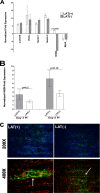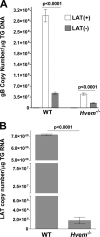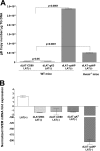Interactions between herpesvirus entry mediator (TNFRSF14) and latency-associated transcript during herpes simplex virus 1 latency
- PMID: 24307582
- PMCID: PMC3911542
- DOI: 10.1128/JVI.02467-13
Interactions between herpesvirus entry mediator (TNFRSF14) and latency-associated transcript during herpes simplex virus 1 latency
Abstract
Herpesvirus entry mediator (HVEM) is one of several cell surface proteins herpes simplex virus (HSV) uses for attachment/entry. HVEM regulates cellular immune responses and can also increase cell survival. Interestingly, latency-associated transcript (LAT), the only viral gene consistently expressed during neuronal latency, enhances latency and reactivation by promoting cell survival and by helping the virus evade the host immune response. However, the mechanisms of these LAT activities are not well understood. We show here for the first time that one mechanism by which LAT enhances latency and reactivation appears to be by upregulating HVEM expression. HSV-1 latency/reactivation was significantly reduced in Hvem(-/-) mice, indicating that HVEM plays a significant role in HSV-1 latency/reactivation. Furthermore, LAT upregulated HVEM expression during latency in vivo and also when expressed in vitro in the absence of other viral factors. This study suggests a mechanism whereby LAT upregulates HVEM expression potentially through binding of two LAT small noncoding RNAs to the HVEM promoter and that the increased HVEM then leads to downregulation of immune responses in the latent microenvironment and increased survival of latently infected cells. Thus, one of the mechanisms by which LAT enhances latency/reactivation appears to be through increasing expression of HVEM.
Figures








Similar articles
-
Herpes Simplex Virus 1 Latency and the Kinetics of Reactivation Are Regulated by a Complex Network of Interactions between the Herpesvirus Entry Mediator, Its Ligands (gD, BTLA, LIGHT, and CD160), and the Latency-Associated Transcript.J Virol. 2018 Nov 27;92(24):e01451-18. doi: 10.1128/JVI.01451-18. Print 2018 Dec 15. J Virol. 2018. PMID: 30282707 Free PMC article.
-
Herpes Simplex Virus 1 Small Noncoding RNAs 1 and 2 Activate the Herpesvirus Entry Mediator Promoter.J Virol. 2022 Feb 9;96(3):e0198521. doi: 10.1128/JVI.01985-21. Epub 2021 Dec 1. J Virol. 2022. PMID: 34851143 Free PMC article.
-
Restoring Herpesvirus Entry Mediator (HVEM) Immune Function in HVEM-/- Mice Rescues Herpes Simplex Virus 1 Latency and Reactivation Independently of Binding to Glycoprotein D.J Virol. 2020 Jul 30;94(16):e00700-20. doi: 10.1128/JVI.00700-20. Print 2020 Jul 30. J Virol. 2020. PMID: 32522859 Free PMC article.
-
A comparison of herpes simplex virus type 1 and varicella-zoster virus latency and reactivation.J Gen Virol. 2015 Jul;96(Pt 7):1581-602. doi: 10.1099/vir.0.000128. Epub 2015 Mar 20. J Gen Virol. 2015. PMID: 25794504 Free PMC article. Review.
-
Herpesvirus Entry Mediator and Ocular Herpesvirus Infection: More than Meets the Eye.J Virol. 2017 Jun 9;91(13):e00115-17. doi: 10.1128/JVI.00115-17. Print 2017 Jul 1. J Virol. 2017. PMID: 28404853 Free PMC article. Review.
Cited by
-
Identification of potential mRNA panels for severe acute respiratory syndrome coronavirus 2 (COVID-19) diagnosis and treatment using microarray dataset and bioinformatics methods.3 Biotech. 2020 Oct;10(10):422. doi: 10.1007/s13205-020-02406-y. Epub 2020 Sep 11. 3 Biotech. 2020. PMID: 33251083 Free PMC article.
-
Decreased reactivation of a herpes simplex virus type 1 (HSV-1) latency-associated transcript (LAT) mutant using the in vivo mouse UV-B model of induced reactivation.J Neurovirol. 2015 Oct;21(5):508-17. doi: 10.1007/s13365-015-0348-9. Epub 2015 May 22. J Neurovirol. 2015. PMID: 26002839 Free PMC article.
-
Knockout of signal peptide peptidase in the eye reduces HSV-1 replication and eye disease in ocularly infected mice.PLoS Pathog. 2022 Oct 10;18(10):e1010898. doi: 10.1371/journal.ppat.1010898. eCollection 2022 Oct. PLoS Pathog. 2022. PMID: 36215312 Free PMC article.
-
Regulation of Notch-mediated transcription by a bovine herpesvirus 1 encoded protein (ORF2) that is expressed in latently infected sensory neurons.J Neurovirol. 2016 Aug;22(4):518-28. doi: 10.1007/s13365-015-0394-3. Epub 2016 Feb 3. J Neurovirol. 2016. PMID: 26846632
-
A Journey through the Minefield of the Discovery and Characterization of Latency-Related RNA/Latency-Associated Transcript.Viruses. 2024 Sep 30;16(10):1562. doi: 10.3390/v16101562. Viruses. 2024. PMID: 39459896 Free PMC article. Review.
References
Publication types
MeSH terms
Substances
Grants and funding
- T32 AI89553/AI/NIAID NIH HHS/United States
- R01 EY013191/EY/NEI NIH HHS/United States
- AI093941/AI/NIAID NIH HHS/United States
- EY15557/EY/NEI NIH HHS/United States
- R01 AI067890/AI/NIAID NIH HHS/United States
- EY13615/EY/NEI NIH HHS/United States
- R01 AI048073/AI/NIAID NIH HHS/United States
- R37 AI033068/AI/NIAID NIH HHS/United States
- T32 AI089553/AI/NIAID NIH HHS/United States
- R01 EY014966/EY/NEI NIH HHS/United States
- P20 RR015635/RR/NCRR NIH HHS/United States
- R21 AI093941/AI/NIAID NIH HHS/United States
- R01 AI033068/AI/NIAID NIH HHS/United States
- 1P20RR15635/RR/NCRR NIH HHS/United States
- EY14966/EY/NEI NIH HHS/United States
- R37AI033068/AI/NIAID NIH HHS/United States
- R01 EY013615/EY/NEI NIH HHS/United States
- R01 EY015557/EY/NEI NIH HHS/United States
LinkOut - more resources
Full Text Sources
Other Literature Sources
Molecular Biology Databases
Research Materials

